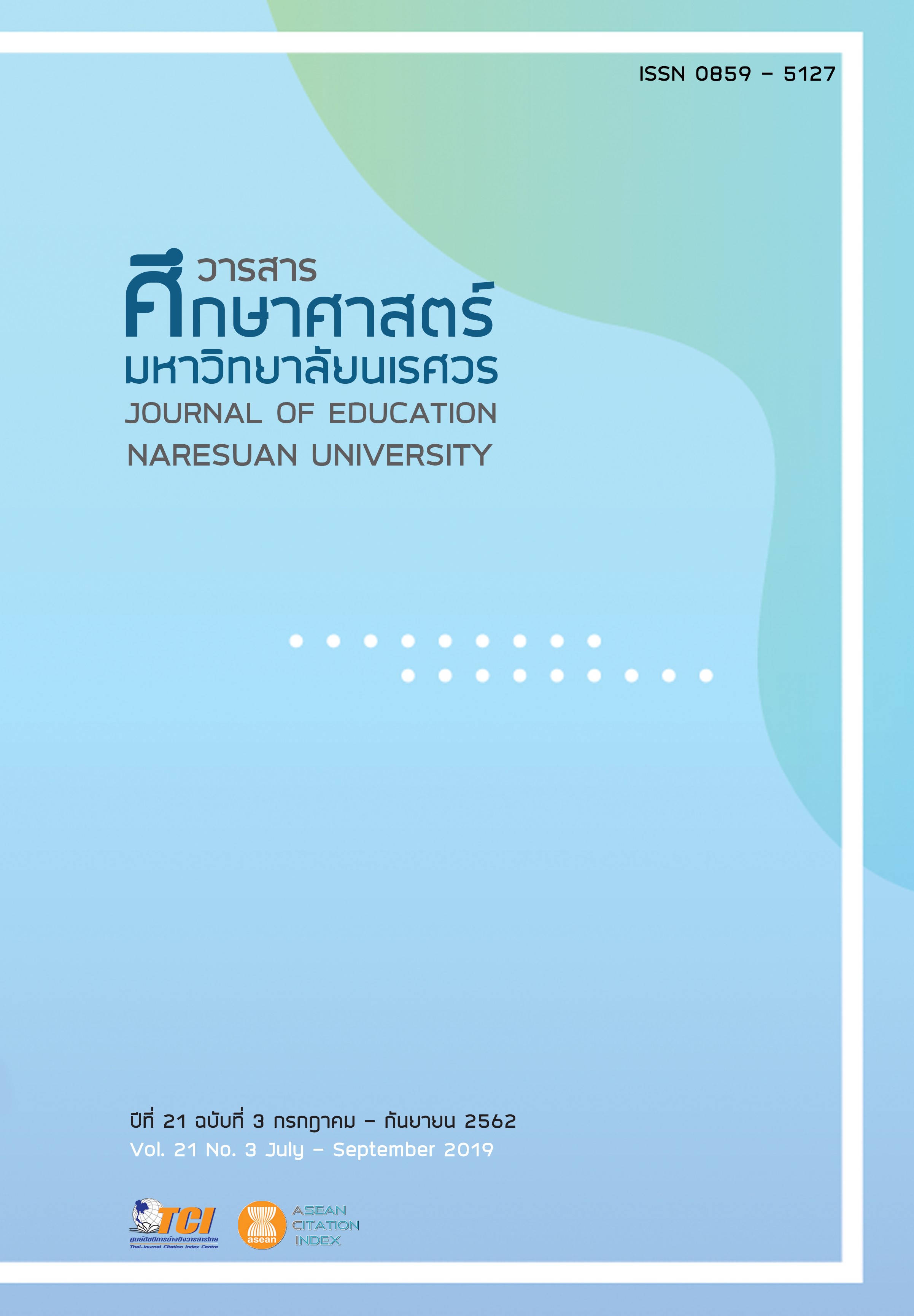การพัฒนารูปแบบการจัดการเรียนรู้วิทยาศาสตร์ตามแนวคิดสะเต็มศึกษาที่ส่งเสริมจิตวิทยาศาสตร์และทักษะการแก้ปัญหาสำหรับนักเรียนระดับประถมศึกษา (A DEVELOPMENT OF SCIENCE INSTRUCTIONAL MODEL BASED ON STEM EDUCATION APPROACH TO ENHANCE SCIENTIFIC MIND AND PROBLEM SOLVING SKILLS FOR PRIMARY STUDENTS)
Main Article Content
Abstract
การวิจัยนี้มีวัตถุประสงค์เพื่อพัฒนารูปแบบการจัดการเรียนรู้วิทยาศาสตร์ตามแนวคิดสะเต็มศึกษาที่ส่งเสริมจิตวิทยาศาสตร์และทักษะการแก้ปัญหาสำหรับนักเรียนระดับประถมศึกษา โดยมีวัตถุประสงค์เฉพาะ คือ 1) การสร้างและหาคุณภาพของรูปแบบการจัดการเรียนรู้วิทยาศาสตร์สะเต็มศึกษาที่ส่งเสริมจิตวิทยาศาสตร์และทักษะการแก้ปัญหาสำหรับนักเรียนระดับประถมศึกษา 2) ศึกษาผลการทดลองใช้รูปแบบการจัดการเรียนรู้ฯ โดยมีขั้นตอนการวิจัย 2 ขั้นตอน ดั้งนี้ ขั้นตอนที่ 1 สร้างและหาคุณภาพรูปแบบการจัดการเรียนรู้ฯ โดยผู้ทรงคุณวุฒิ 9 ท่าน และทดลองนำร่องเพื่อพิจารณาความเป็นไปได้กับนักเรียนที่ไม่ใช่กลุ่มตัวอย่าง จำนวน
1 ห้องเรียน ขั้นตอนที่ 2 ศึกษาผลการทดลองใช้รูปแบบการจัดการเรียนรู้ โดยนำไปทดลองใช้กับนักเรียนชั้นประถมศึกษาปีที่ 6 โรงเรียนบ้านจำบอน สังกัดสำนักงานเขตพื้นที่การศึกษาประถมศึกษาพะเยา เขต 1 จำนวน 1 ห้องเรียน จำนวน 15 คน ได้จากการเลือกแบบเจาะจง ทั้งนี้ผู้บริหารและคุณครูมีความสมัครใจและเต็มใจในการร่วมกิจกรรมการเรียนการสอน ผลการวิจัย พบว่า
1. ผลการสร้างและศึกษาคุณภาพรูปแบบ มีดังนี้
1.1 รูปแบบการจัดการเรียนรู้ที่พัฒนาขึ้น คือ รูปแบบการจัดการเรียนรู้วิทยาศาสตร์ตามแนวคิดสะเต็มศึกษาที่ส่งเสริมจิตวิทยาศาสตร์และทักษะการแก้ปัญหา สำหรับนักเรียนระดับประถมศึกษา มี 5 องค์ประกอบ คือ หลักการ วัตถุประสงค์ เนื้อหา กระบวนการจัดการเรียนรู้ การวัดและประเมินผล กิจกรรมการเรียนรู้มี 6 ขั้น คือ ขั้นท้าทายให้กระหายใคร่รู้ ขั้นมุ่งสู่การเก็บรวบรวมข้อมูล ขั้นตั้งศูนย์ร่วมวางแผนปฏิบัติการ ขั้นสานต่อการสร้างสรรค์ผลงาน ขั้นวิพากษ์ ทบทวน ชวนกันสะท้อน และขั้นป้อนผลลัพธ์กลับสู่สังคม โดยเมื่อจัดกิจกรรมการเรียนการสอนครบทั้ง 6 ขั้นแล้ว ผู้เรียนจะได้รับองค์ความรู้ที่เกิดจากการบูรณาการแบบสหวิทยาการครบทั้ง 4 ศาสตร์ ได้แก่ วิทยาศาสตร์ เทคโนโลยี วิศวกรรมศาสตร์ และคณิตศาสตร์
1.2 รูปแบบการจัดการเรียนรู้ที่พัฒนาขึ้นมีความเหมาะสมอยู่ในระดับมาก
1.3 ผลการทดลองนำร่องเพื่อหาค่าดัชนีประสิทธิผล พบว่า ค่าดัชนีประสิทธิผลมีค่าเท่ากับ 0.62113
2. ผลของการทดลองใช้รูปแบบการจัดการเรียนรู้ พบว่า
2.1 นักเรียนมีจิตวิทยาศาสตร์หลังเรียนสูงกว่าก่อนเรียนอย่างมีนัยสำคัญทางสถิติที่ระดับ .01
2.2 นักเรียนมีทักษะการแก้ปัญหาหลังเรียนสูงกว่าก่อนเรียนอย่างมีนัยสำคัญทางสถิติที่ระดับ .01
2.3 นักเรียนมีผลสัมฤทธิ์ทางการเรียนหลังเรียนสูงกว่าก่อนเรียนอย่างมีนัยสำคัญทางสถิติที่ระดับ .01
2.4 ครูและนักเรียนมีความคิดเห็นว่าการจัดการเรียนรู้ตามแนวคิดสะเต็มศึกษา เป็นการเปิดโอกาสให้นักเรียนได้แสดงออกทางความคิดและการปฏิบัติ นักเรียนเรียนรู้อย่างกระตือรือร้น และมีความสุขเป็นการจัดกิจกรรมการเรียนรู้ที่ยึดผู้เรียนเป็นสำคัญ ส่งผลให้นักเรียนสามารถแก้ปัญหาได้อย่างสร้างสรรค์และก่อให้เกิดนวัตกรรมสิ่งประดิษฐ์ใหม่
A DEVELOPMENT OF SCIENCE INSTRUCTIONAL MODEL BASED ON STEM EDUCATION APPROACH TO ENHANCE SCIENTIFIC MIND AND PROBLEM SOLVING SKILLS FOR PRIMARY STUDENTS
The main purpose of this research was to develop a science instructional model based on STEM education approach to enhance scientific mind and problem solving skills for primary students. The specific purposes of this research were to develop and assess the quality of the model and to study the results of using the model. The procedure followed two steps: 1) to develop and examine instructional model inclusive of supplementary documents of instructional model inclusive supplementary documents of instructional model by 9 experts and launch of pilot trial on instruction model to seek effectiveness index with non-group of primary schools for a classroom, and 2) to implement the instructional model with primary school student year 6 for a classroom at Bannchambon school in Phayao Primary Educational Service Area Office 2. The finding were as follows:
1. The finding from development and assessment the quality of the model found;
1.1 The instructional model developed by the researcher consists of 5 factors; principles, objective, content, operational procedure, measurement and evaluation. The teaching and learning through the activities following the 5 stages; curiosity, collection of data, collaborative planning, creative and innovation, comments and consideration, and communication service.
1.2 The experts agreed to the quality of the developed model and supplementary materials at high level.
1.3 Effectiveness Index of the proposed science instructional model is equal to 0.6211.
2. The finding from using the instructional model found;
2.1 The student’s scientific mind after the intervention was significantly higher than before at .01.
2.2 The student’s problem solving skills after the intervention was significantly higher than before at .01.
2.3 The student’s achievement after the intervention was significantly higher than before at .01.
2.4 The Teachers and students’ opinions regarding to the STEM education classroom management are given opportunities for students to express their ideas and actions. Students are energetic and happy to learn. The learning activities are based on students’ center. As a result, students are creatively solving the problems and creating new inventions and innovations.
Article Details
The owner of the article does not copy or violate any of its copyright. If any copyright infringement occurs or prosecution, in any case, the Editorial Board is not involved in all the rights to the owner of the article to be performed.
References
2. Arends, B. (1999). Practical instructional design: Applying the basics to your online course. Retrieved May 2, 2012, from https://leahi.kcc.hawaii.edu/org/tcon99/papers/arend.html
3. Chaolumbua, S. (2015). Development of an additional STEM integrated science curriculum on “Sugar Cane” for the 9th grade students. Journal of Education Srinakharinwirot University, 26(1), 224-226. [in Thai]
4. Dowey, A. L. (2013). Attitudes, interest, and perceived self-efficacy toward science of middle school minority female students: Considerations for their low achievement and participation in STEM disciplines (Doctoral dissertation). California: University of California.
5. Hamra, K., & Samahito, C. (2016). STEM education activity provision on good products in Roi Et to develop problem- solving ability in young children. Journal of Kasetsart educational review, Kasetsart University, 31(3), 153-158. [in Thai]
6. Jitaree, R., Uaiy, V., & Keawurai, W. (2017). The development of instruction model based on constructivist learning theory and STEM Education approach to enhance analysis thinking and scientific literacy for Mathayomsuksa 1 student. Journal of Education Naresuan University, 19(2), 202-212. [in Thai]
7. Joyce, B. R., & Weil, E. A. (2004). Model of teaching (7th ed.). London: Allyn & Bacon.
8. Kaewurai, W. (2010). A development of learning management model for developing quality of learner leading to moral, wisdom, and learning society. Journal of Graduate Studies in Northern Rajabhat Universities, 6(15), 11-30. [in Thai]
9. Khammani, T. (2011). Instructional of model: A variety of choices (7th ed.) Bangkok: Chulalongkorn University Press. [in Thai]
10. Kijkuakul, S. (2015). STEM Education (Part II): How to integrate STEM Education in classroom teaching. Journal of Education Naresuan University, 17(3), 154-160. [in Thai]
11. Klomim, K. (2016). Learning management based on STEM Education for student teachers. Journal of Education Naresuan University, 16(2), 129-139. [in Thai]
12. Paugsuntrar, S. (2010). Development of a scientific mind test for primary school students. (Doctor dissertation). Bangkok: Chulalongkorn University. [in Thai]
13. Pongpaiboon, P. (2009). Create a nation by education. Bangkok: Thai Watanapanich. [in Thai]
14. Sangpharmsri, P., Nuengchalerm, P., & Tirithikul, C. (2015). Comparisons of learning achievement, integrated science process skills, and attitude towards chemistry learning for Matthayomsueksa 5 students between STEM education and conventional methods. Journal of Education Mahasarakham University, 9(Special Edition), 401-418. [in Thai]
15. The institute for the promotion of Teaching Science and Technology. (2003). The management of learning area of science in basic education. Bangkok: The institute for the promotion of Teaching Science and Technology. [in Thai]
16. The institute for the promotion of Teaching Science and Technology. (2015). Manual of STEM Activity for Prathoomsuksa 1-3. Bangkok: BOWT. [in Thai]


